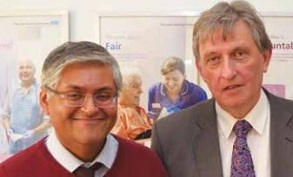Feature / Costing clarity
 Back in 2007, Tony Whitfield – then finance director at Salford Royal NHS Foundation Trust – called on the NHS to move beyond the crude averages at the heart of NHS reference costs and start ‘costing for business’ by costing down to the patient level. Nearly nine years later, has the NHS taken up his challenge?
Back in 2007, Tony Whitfield – then finance director at Salford Royal NHS Foundation Trust – called on the NHS to move beyond the crude averages at the heart of NHS reference costs and start ‘costing for business’ by costing down to the patient level. Nearly nine years later, has the NHS taken up his challenge?
The short answer is probably ‘no’ – or at least not as quickly as he or many others would have liked. But the prescription for change remains the same. The NHS needs a far greater understanding of what it costs to treat patients, the different components of those costs and how costs vary from one patient to another. What has changed is that there are a lot more people making the same argument and championing patient-level costing. And there is now a national programme – likely to become mandatory at some point – that aims to get the whole service costing individual patients using a common methodology.
Mr Whitfield was one of the early pioneers of patient-level costing and led the HFMA’s early work in the area, including overseeing the initial production of voluntary clinical costing standards. His belief that finance and clinicians needed to understand each other’s business better – with costing providing a perfect meeting place – underpinned his ‘knowing the business’ theme while he was HFMA president in 2013.
Scale of the task
Now at Leeds Teaching Hospitals NHS Trust, he is in a different environment from Salford. The trust is more than twice the size, for a start. Many of its clinical service units – cancer, cardio and respiratory and the Leeds Children’s Hospital – are as big as some freestanding NHS trusts or foundation trusts.
The NHS is also in a completely different financial place than it was eight to nine years ago. Back then, the service overall was in surplus and tariffs were increasing year-on-year. But Mr Whitfield says the current widespread financial challenges make an even stronger case for having a forensic understanding of costs.
Deficits and recovery plans may put all but essential spending off limits, but Mr Whitfield remains clear that investing in better cost data is essential. It is part of the solution and not a way of exacerbating the current financial position.
And Mr Whitfield can back up his words with actions. Leeds Teaching Hospitals NHS Trust delivered a £24m deficit in 2014/15 against a planned £50m – the improvement largely thanks to non-recurrent income support from the Trust Development Authority and depreciation savings following a major asset revaluation. The challenges have continued into 2015/16, with the most recent board reports forecasting a year-end deficit of £31m, again using non-recurrent support to improve on a planned £37m deficit. Achieving this would keep the trust on course for its planned ‘return to sustainable break-even’ in 2017/18.
But even given these pressures, replacing finance systems – including the ledger, costing and contracting systems – was a priority when Mr Whitfield joined the trust in January 2014. Although the trust had nominally been pursuing patient-level costing, Mr Whitfield says he found a good costing team struggling with poor systems, which compromised the quality and the usefulness of the cost data produced.
Cost data was poorly regarded in the organisation and in reality the trust’s sole focus was the annual reference cost return. ‘It was my decision that we needed a new costing system,’ says Mr Whitfield. ‘But I wanted the team to decide on the actual system we would use.’
So that’s what happened with the costing team, after a proper competition, selecting the Healthcost patient-level costing system.
The contract was signed in March 2015, giving the costing team just 20 weeks to implement a new system and meet the 2014/15 reference cost submission deadlines. ‘Our costs were compiled to a degree of granularity that hadn’t been achieved previously and we were starting to produce useful data,’ says Mr Whitfield. 
He openly admits that there is a huge improvement programme stretching out ahead of the costing team – the trust is probably close to being in the same position as Salford back in 2007. But he credits his costing team with making ‘amazing progress’ in what has been a ‘fabulous start’. Delivering detailed patient costs requires clinical engagement, new feeder systems and an iterative process improving data and the allocation methods employed. This can’t be achieved overnight, but if you don’t start the process, you will never achieve the end goal.
Trust head of costing Vinod Bassi says the final contract signing had been later than planned, leaving less time than they’d wanted to implement the system. ‘But this pushed us to get out in the trust and validate our results as we went along,’ he says.
He is also delighted with the new system. ‘It used to take 26 hours to do a run of data and it often fell over. Now it takes four hours and it is much more transparent about where it encounters any blockages.’
Mr Bassi suggests the trust had been in a ‘costing wilderness’. ‘We were just focused on filling in the statutory returns,’ he says. ‘No-one used the cost information. There was no validation or clinical engagement. It has been a renaissance.’ There is now renewed enthusiasm in the team, much greater professional satisfaction and ambition to do more – supported by an active costing system user group – and make a difference to patient care.
Mr Whitfield says this is exactly the right reaction. ‘I want them to be proud of being advocates of great care, not spreadsheet warriors,’ he says. And he remains convinced that all providers need to be pursuing similar approaches.
Pace of change
In general, Mr Whitfield says he is disappointed with how long it has taken the NHS as a whole to get behind patient-level costing. ‘The service hasn’t embraced costing at the level it should have. And in general terms, it is not where our best people aspire to work – that is still something that has to change,’ he adds. Too often when good people end up in costing, they feel they have to move on – into financial management more generally – to further their careers. ‘This has to change,’ he says.
Cost data often provides the best way of examining variation in clinical practice – or even just spotting where attention could best be focused to find improvement. ‘And there is increasing consensus around the need for new models of care to deliver services going forward,’ he says. ‘But we can’t move into these new models without understanding their affordability – or if they cost more; we need to understand the value they deliver. Accountants can’t describe the new models we need to deliver, but we can and have to be part of the decision-making process by ensuring tha we are factoring in an understanding of what will happen to costs.’
Mr Whitfield says that cost data is important for tariff-setting – with new tariffs and payment mechanisms needed to underpin the new models of care. But, echoing comments from NHS Improvement, he insists the prime reason to improve costing is to understand how services are delivered and inform decision-making.
‘It has a major role in supporting clinical groups to highlight unwarranted variation. A first step might be to ask if we can deliver services for the tariff price. If we can’t, perhaps other providers should be taking on the work. And if we can, we need to ask if anybody is doing it more cost effectively. If so – and the outcomes are good or comparable – what can we do to improve?’
However, important decisions such as these can’t be taken if people – finance practitioners and clinicians – don’t buy into the cost data and believe what it is telling them.
Despite a new system and approach at Leeds being barely 12 months old, there have  already been early wins. The trust has been able to evidence underpayment for some specialised abdominal surgery.
already been early wins. The trust has been able to evidence underpayment for some specialised abdominal surgery.
However, Mr Whitfield is clear that the key benefits need to come from using the data to reduce costs, not increase income. ‘With the spending squeeze, it may feel as though we have no money to spend, but in reality we are spending £3m every day. The question is: are we using it to the best effect?’
Patient cost dashboards – with a specific version targeted at clinicians – are now available to all the trust’s clinical service units. And data is now refreshed on a monthly basis rather than just twice a year, as before. Unassisted take-up of the data and use of the dashboards is limited, but the trust has done some more detailed work with some pilot areas under the guidance of clinical costing champion Dr Stuart Murdoch, chair of the trust’s patient-level information and costing board.
This has included orthopaedic surgery, where work is being undertaken to identify waste and inefficiency – part of an initiative called the Leeds Improvement Method, developed with the Trust Development Authority and the US Virginia Mason Institute. While the focus of the work is around eliminating errors and never events and reducing waste, Mr Whitfield is clear that the trust also wants to demonstrate it is reducing unit costs – making accurate cost data vital.
He says the danger is that over recent years, clinical units may have slid into financial unsustainability with the central finance team doing what it can to deliver the financial position.
‘This has been hugely disengaging for clinicians and there has been no narrative about how to get back into financial sustainability – just imposed cost improvement programmes. This has been characterised by very top-down approaches such as vacancy freezes. The new leadership team has brought these blunt measures to an end.’
The trust’s values include empowering staff and holding them to account. ‘But you can’t hold people to account for a financial plan without clarity about the data they need to deliver the plan,’ says Mr Whitfield. ‘That means giving them the absolute performance numbers and showing them where the opportunities are for maximising value. That is where the cost data comes in.’
The trust has big plans to improve costing. It currently has no acuity system, although it has created a bespoke system to weight catheter laboratory minutes for different procedures – helping to produce more meaningful costs for its cardio-respiratory department. It is about to launch a new data warehouse, to bring all its data in one place. And it is keen to start putting cost data alongside outcome measures – there are plans for a specific project looking at cancer trends.
Barcode pilot
But perhaps its biggest project involves a move to adopt the GS1 ‘barcode’ standards – it is one of six formal GS1 pilot sites. The focus of the work is to improve procurement and stock control (and enhance safety), giving far greater visibility over what trusts use and what they pay for goods and services. But a knock-on benefit is the ability to trace consumption of specific resources to individual patients, eventually doing away with whole swathes of cost apportionment and allocation approaches.
‘It is really exciting – we’ll have the ability to scan patients, staff, blood, consumable and OPCS codes – the possibilities are huge,’ says Mr Whitfield. ‘But it will make our ability to identify, analyse and understand variation so much greater.’ He maintains that it takes ‘about five years before patient-level costing is business as usual’, with the benefits accumulating each year of the journey. It might be frustrating not to be able to access all the benefits immediately. But the important thing is to take the first step.
Related content
The Institute’s annual costing conference provides the NHS with the latest developments and guidance in NHS costing.
The value masterclass shares examples of organisations and systems that have pursued a value-driven approach and the results they have achieved.